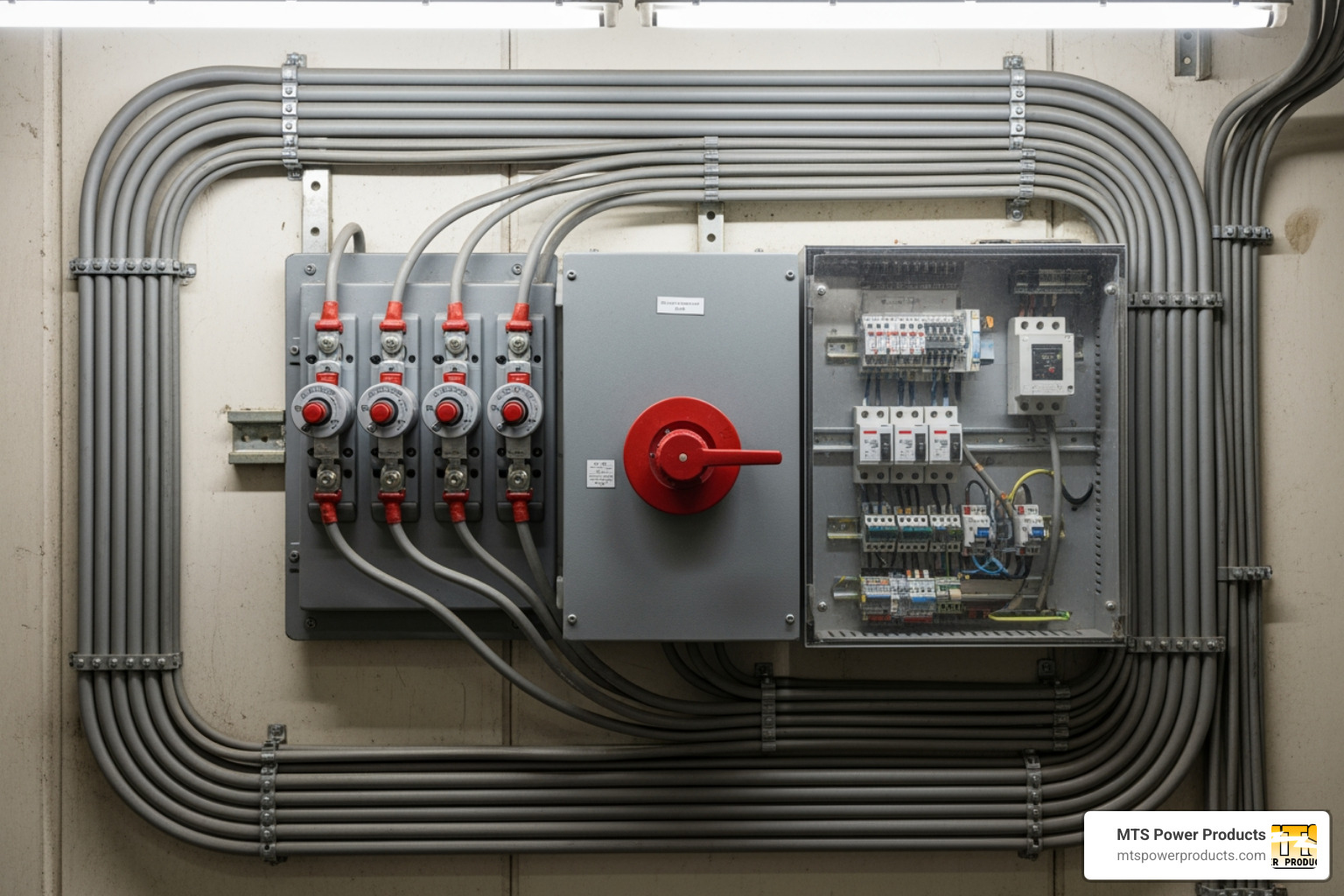
Buy Direct
from the Manufacturer
Sell our Products
Become a Distributor
Discounts
on volume purchases
Visit Us
at our Miami office
from the Manufacturer
Become a Distributor
on volume purchases
at our Miami office
When power outages strike, an automatic interlock transfer switch ensures seamless backup power and prevents dangerous electrical hazards. These devices safely connect your generator to your home’s electrical system, preventing deadly backfeeding to utility lines.
Quick Answer for Automatic Interlock Transfer Switch:
The reality is stark – connecting any unauthorized power source directly into electrical wiring without a changeover switch is illegal and dangerous because of backfeeding. This makes choosing the right transfer method crucial for your family’s safety.
For South Florida residents facing hurricane season, or facility managers ensuring uninterrupted operations, understanding your options between manual interlocks and automatic transfer switches can prevent costly downtime and protect lives.
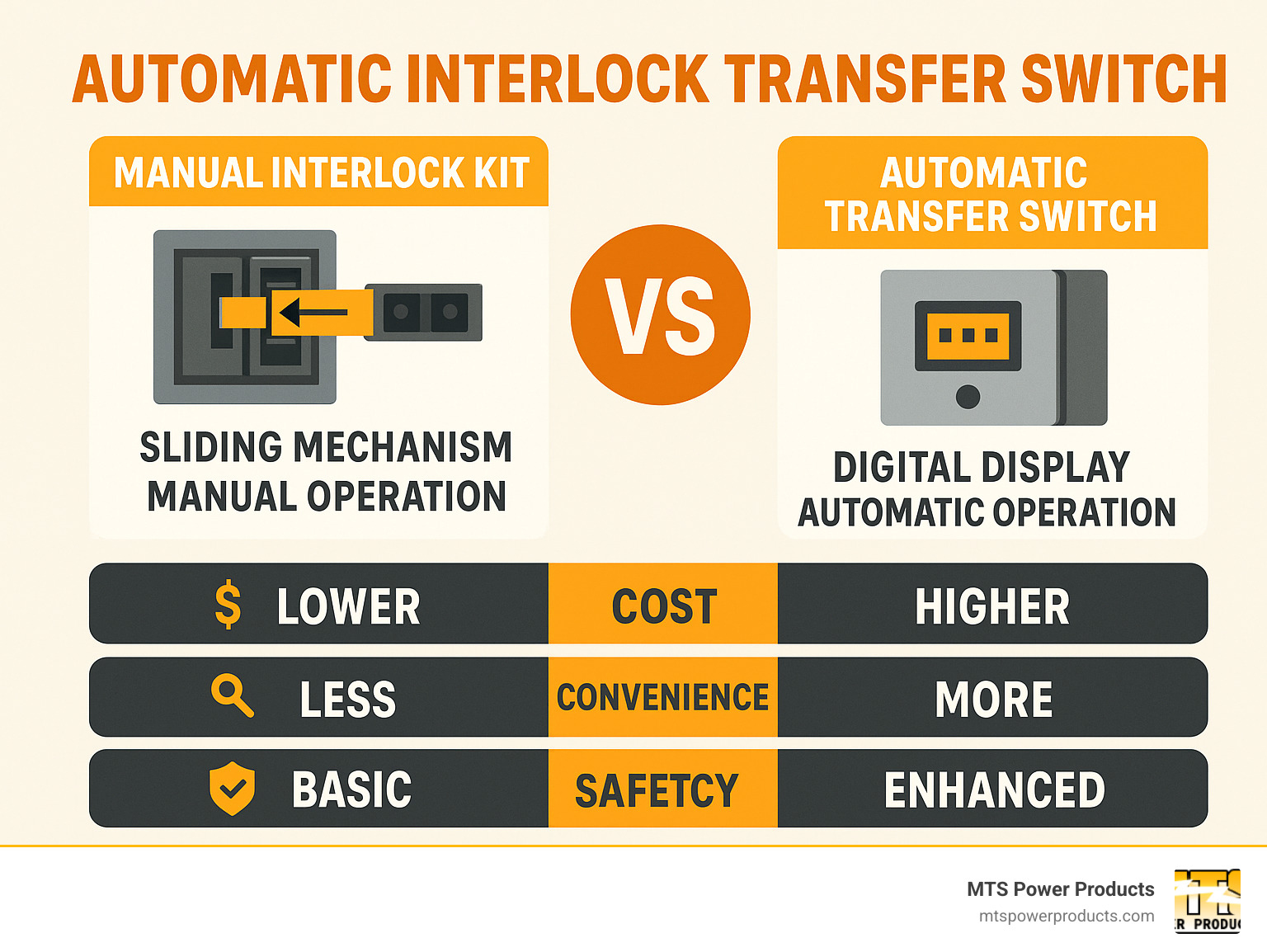
Must-know automatic interlock transfer switch terms:
When a power outage hits, you need a safe way to connect your backup generator. This section defines the two primary methods—interlock kits and transfer switches—highlighting their differences in design and operation.
Both solutions prevent dangerous backfeeding, but they take different approaches. One is manual, while the other works like a smart assistant that handles everything automatically.
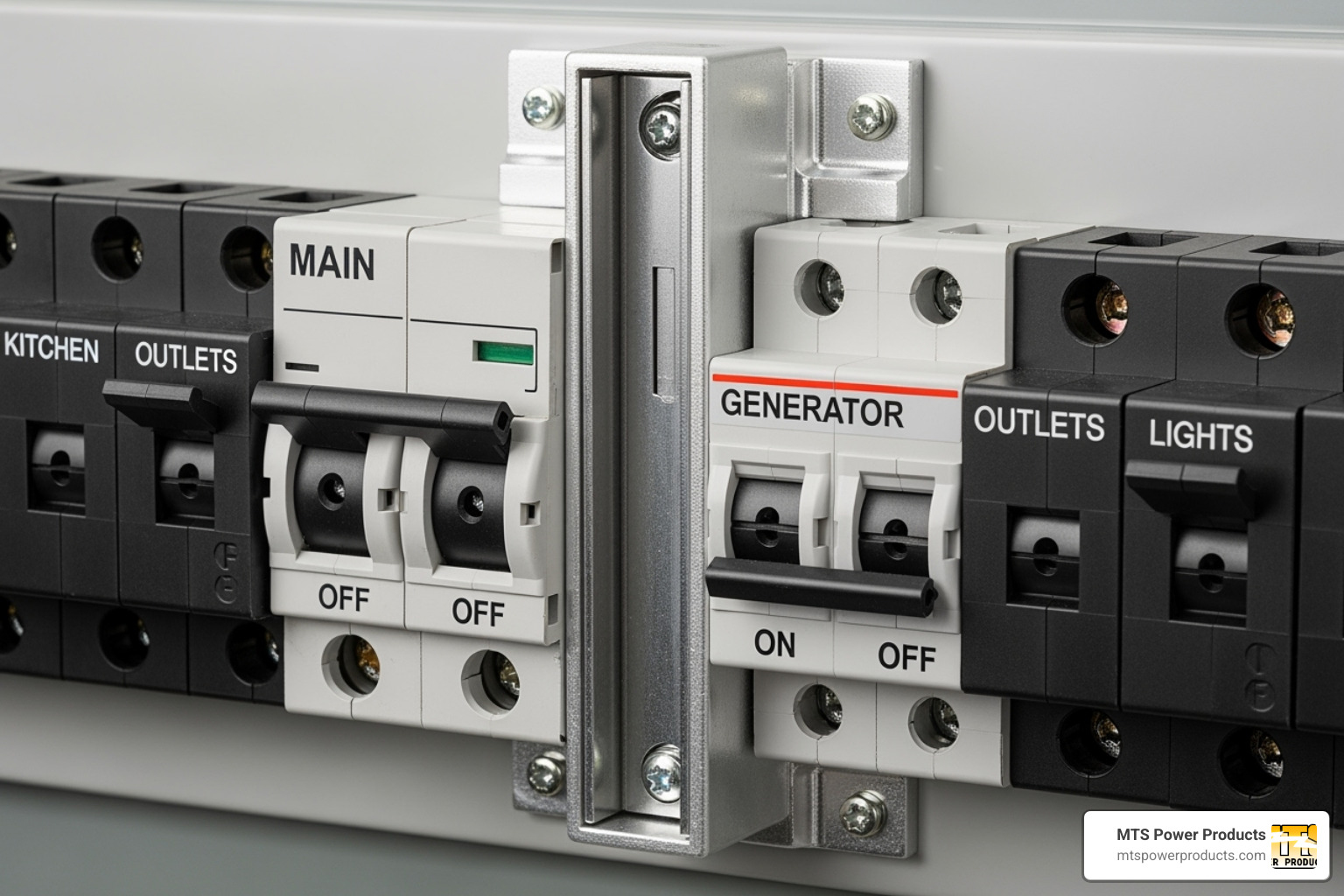
An interlock kit is a straightforward yet highly effective device that ensures safe generator operation by allowing only one power source to be active at a time. The magic happens through a mechanical slide system that’s installed directly on your existing breaker panel. This breaker panel modification is relatively minor, making it a cost-effective solution for many homeowners.
Here’s how the manual operation works: when the power goes out, you manually shut off your main utility breaker, slide the interlock plate to block it from being turned back on, then flip on your generator breaker. The beauty of this design is that it prevents the main and generator breaker from being on simultaneously – no matter what.
This mechanical approach means there’s no complex electronics to fail, no sensors to malfunction, and no programming required. You’re in complete control of when and how your backup power kicks in.
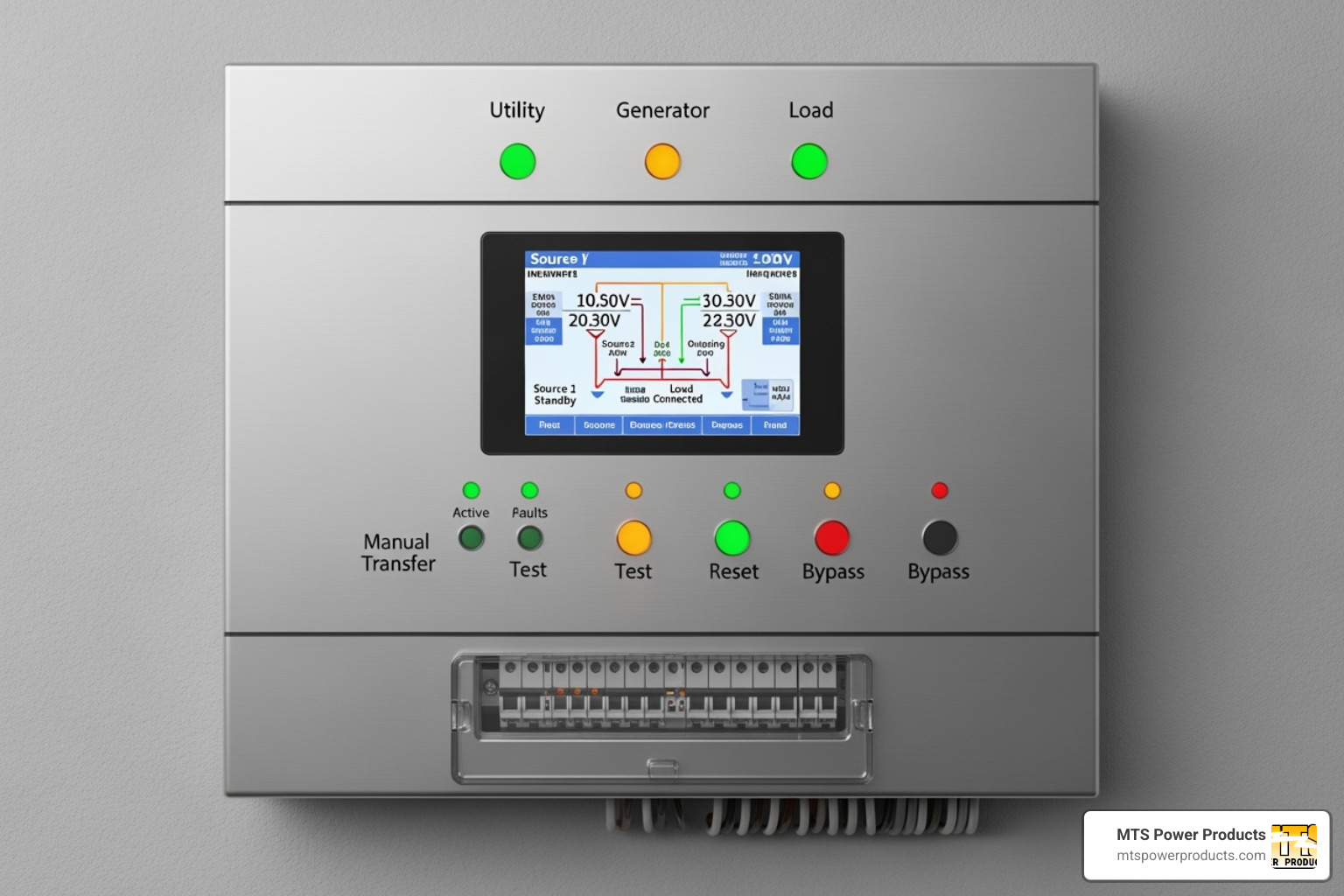
A transfer switch is the sophisticated cousin of the interlock kit. This pivotal component in power management enables a seamless and secure shift between utility and generator power, taking the guesswork out of backup power management.
Transfer switches come in manual vs. automatic types, each serving different needs. Manual transfer switches work through a sub-panel system where you manually select which circuits get power from your generator. They give you precise control over your electrical loads without the complexity of managing your entire main panel.
But the real game-changer is the automatic transfer switch – often called an automatic interlock transfer switch. These intelligent devices provide true whole-house power management by automatically detecting when your power loss occurs. Once detected, they switch sources automatically without any action needed from you.
Picture this: you’re sleeping soundly during a storm when the power goes out. An automatic transfer switch detects power loss within seconds, signals your generator to start, waits for it to stabilize, then smoothly transfers your home’s electrical load. When utility power returns, it reverses the process and shuts down the generator. You might wake up never knowing the power was out at all.
This automation makes automatic transfer switches perfect for protecting sensitive electronics, ensuring continuous power for medical equipment, or simply providing peace of mind when you’re away from home.
For more detailed information about your options, check out our Helpful Info on Generator Transfer Switch Options.
When you’re in the dark during a power outage, the differences between backup power solutions become clear. The choice between an interlock kit and an automatic interlock transfer switch often comes down to convenience versus cost.
With an interlock kit, you must manually operate the system during an outage. This involves going to your electrical panel, flipping breakers in the correct sequence, and starting your generator, which can be inconvenient, especially during a storm.
Manual operation means you’re the control system. You’ll need to manage which circuits are on to avoid overloading your generator. While you can power your whole house if your generator has enough juice, you’ll be playing load manager—turning off the air conditioning when you want to run the microwave, for example.
Conversely, an automatic interlock transfer switch handles everything for you. When power cuts out, it automatically starts your generator and switches the power source, restoring electricity to essential circuits within seconds without any manual intervention. When utility power returns, an automatic system switches back just as seamlessly and shuts down your generator. For homeowners seeking maximum convenience—especially those with mobility issues or frequent travelers—this hands-off operation is invaluable.
Our Automatic Transfer Switch for Generator page dives deeper into how these systems work their magic.
Let’s talk numbers, because your budget matters just as much as your convenience preferences.
Interlock kits are the budget-friendly option. A basic kit can cost under $200, and installation is relatively straightforward since it mounts to your existing electrical panel. While you’ll still want a licensed electrician to install it, the job typically involves minimal modification.
Manual transfer switches fall in the middle ground, usually running under $350 for a sub-panel setup. They require more work since you’re often adding a separate transfer panel, but they’re still more affordable than going fully automatic.
Automatic transfer switches represent the premium investment, with residential units ranging from $600 to $2000 or more. The installation is more complex, as these systems integrate with both your main electrical panel and your generator’s control system.
Here’s how they stack up:
| Feature | Interlock Kits | Manual Transfer Switches | Automatic Transfer Switches (ATS) |
|---|---|---|---|
| Cost | Budget-friendly (under $200 for kit) | Moderate (under $350 for sub-panel) | Premium ($600-$2000+ residential) |
| Installation Complexity | Simple panel modification | Moderate sub-panel work | Complex integration required |
| Required Space | Minimal (mounts on existing panel) | Moderate (separate transfer panel) | Significant (standalone control unit) |
| User Action Needed | Full manual operation | Manual switching required | Zero – completely automatic |
| Automation Level | None | None | Complete hands-off operation |
The higher cost of an automatic interlock transfer switch reflects its sophisticated electronics—microprocessors, power sensors, automatic start signals, and safety relays. While the upfront investment is steeper, many homeowners find the convenience and peace of mind worth every penny, especially in areas prone to frequent outages.
Installation complexity increases with automation level. A licensed electrician can usually install an interlock kit in a few hours, while an automatic system might take a full day or more, depending on your setup and local code requirements.
For detailed guidance on what to expect during installation, check out our Generator Transfer Switch Kit: What to Know resource.
When you’re looking for the absolute best in home backup power, nothing beats an automatic interlock transfer switch. Think of it as the Rolls-Royce of power transfer equipment – sophisticated, reliable, and designed to work flawlessly when you need it most.
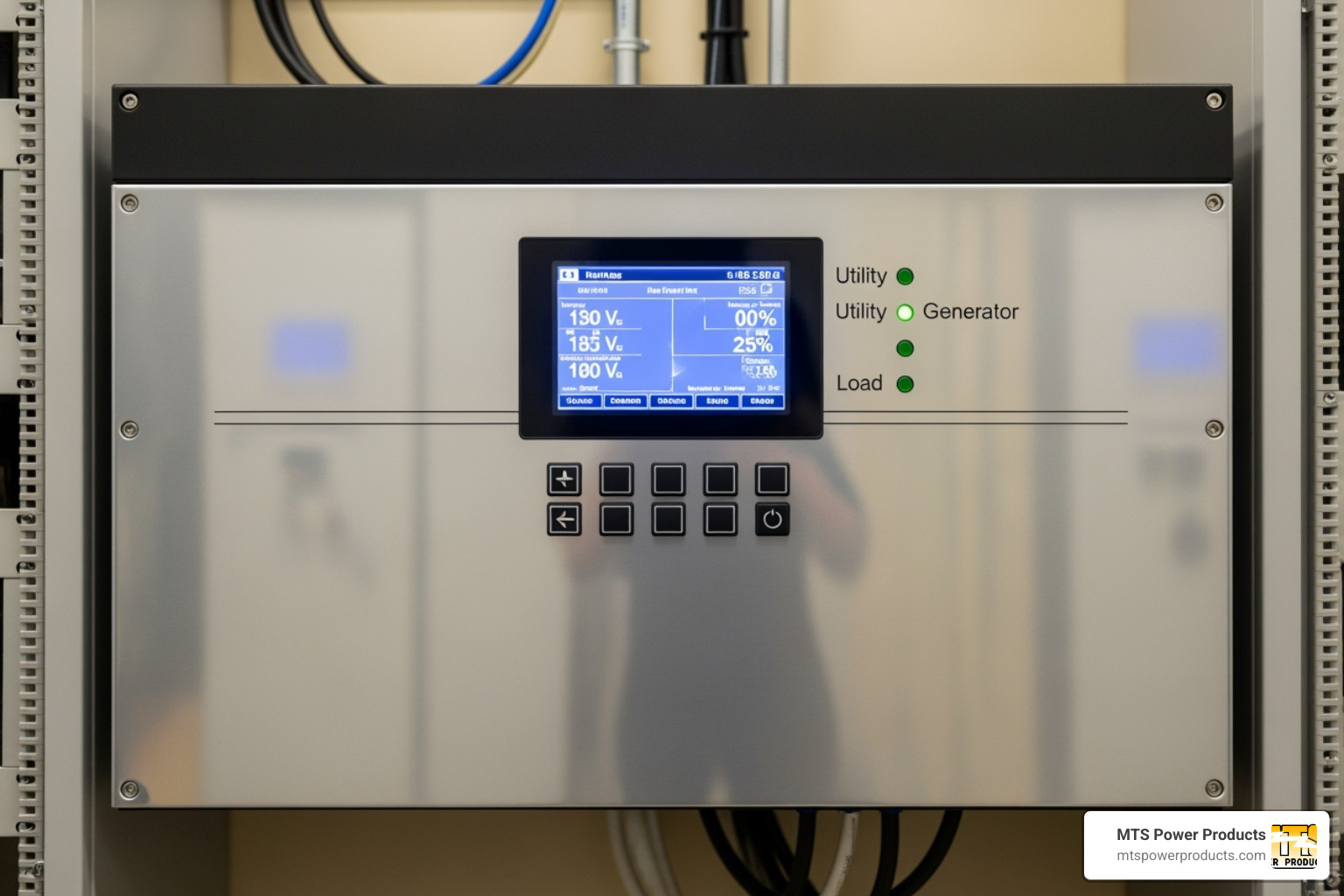
What makes these units so special? It’s all about combining cutting-edge technology with rock-solid safety features. While manual interlocks get the job done, an automatic interlock transfer switch takes everything to the next level with zero effort required from you.
Here’s where the magic really happens. The core mission of any transfer equipment is simple yet critical: allow safe power transfer from utility to generator while absolutely preventing these two power sources from ever connecting simultaneously. An automatic interlock transfer switch doesn’t just meet this requirement – it exceeds it with flying colors.
The break-before-make mechanism is the heart of the safety system. This means the connection to utility power is completely severed before any connection to generator power is made. No dangerous overlap, no risky arcing – just clean, safe transitions every single time.
UL 1008 standard compliance ensures your unit meets the most rigorous safety requirements in the industry. When you see this listing, you know the device has passed extensive testing for safety and performance. It’s like a safety seal of approval that gives you real peace of mind.
The physical interlock design prevents the interconnection of power sources at the mechanical level. Even though it operates automatically, the fundamental interlock principle – keeping utility and generator power completely separate – is built right into the DNA of the device.
Backfeed prevention is perhaps the most crucial safety feature. When utility workers are out restoring power after a storm, they need to know those lines are truly dead. An automatic interlock transfer switch completely isolates your home from the grid when running on generator power, protecting these brave workers from electrocution.
Your home appliances get protection too. By providing stable, isolated generator power, the ATS shields your sensitive electronics from power surges and fluctuations that can happen when utility power kicks back on.
At MTS Power Products, our customized McPherson Controls line takes safety even further. We integrate programmable displays and advanced switch mechanisms that give you better control while maintaining the highest safety standards. Being based right here in South Florida, we understand how critical reliable backup power is during hurricane season.
For deeper insights into professional transfer equipment, check out this comprehensive guide on Transfer Equipment Options and explore our full range of Automatic Transfer Switches for Generators.
So when does an automatic interlock transfer switch make the most sense? The answer is: whenever you want the ultimate in convenience and reliability without any compromise on safety.
Homeowners seeking maximum convenience are the perfect fit for automatic systems. If the thought of trudging out to your electrical panel during a thunderstorm doesn’t appeal to you (and really, who could blame you?), an ATS handles everything automatically. You might not even realize the power went out until you notice your neighbor’s house is dark.
Frequent power outages make automation practically essential. If you live in an area where storms regularly knock out power, or where the electrical grid isn’t as reliable as you’d like, an automatic interlock transfer switch becomes your silent guardian. The system springs into action instantly, keeping your life running smoothly.
Properties with vulnerable residents – whether elderly family members, young children, or anyone with medical needs – benefit enormously from uninterrupted power. Medical equipment, heating and cooling systems, and other critical devices stay operational without missing a beat.
Powering sensitive electronics is another strong suit of automatic systems. The smooth, seamless transition is much gentler on computers, televisions, and other delicate equipment compared to manual switching methods.
Standby generators and automatic transfer switches are made for each other. When you invest in a permanent standby generator, pairing it with an automatic interlock transfer switch creates a complete, hands-free backup power system that works flawlessly together.
The bottom line? If you value peace of mind, continuous operation, and the highest level of safety without any manual effort on your part, an automatic system is the clear winner. Ready to take the next step? Prepare with an Automatic Generator with Transfer Switch and never worry about power outages again.
Think of your backup power system as an investment that needs to pay dividends for years to come. While the initial setup gets all the attention, what happens after installation is equally important. Your automatic interlock transfer switch isn’t just a purchase—it’s a long-term relationship that requires some care and feeding to keep your family safe and comfortable during outages.
Here’s the good news: an automatic interlock transfer switch doesn’t demand daily attention like a needy pet. But it does appreciate some regular TLC to keep performing at its best.
The beauty of an ATS lies in its sophisticated electronics, but those same components need occasional check-ups. Monthly testing is your best friend here—most modern units come with a self-test function that makes this easy. Think of it as a fire drill for your electrical system. You’ll want to make sure the transfer mechanism works smoothly and that your ATS can still “talk” to your generator properly.
Annual professional inspections are worth every penny. A qualified electrician can spot potential issues before they become expensive problems. They’ll check connections, examine contact points, and ensure all those clever electronic components are happy and healthy.
Don’t forget about the battery checks for your control unit. These small backup batteries keep your settings intact and help initiate transfers when needed. Like the batteries in your smoke detector, they’ll need replacing eventually—usually every few years.
Compared to simple mechanical interlocks that just need an occasional cleaning of their sliding plates, an ATS requires more attention. But remember—this extra care is what gives you that incredible convenience and safety automation that makes life so much easier during storms.
Your automatic interlock transfer switch is only as good as the system it’s connected to. Getting the compatibility right is crucial for safe, reliable operation.
Standby generators are the natural partners for an ATS. These permanently installed units are designed to start automatically and work seamlessly with transfer switches. If you’re thinking about using a portable generator, it’s possible but trickier—you’ll often need additional equipment like neutral switching devices to prevent issues like GFCI tripping (a common headache where the generator’s bonded neutral causes circuit breakers to trip unexpectedly).
Your home’s electrical panel needs to be a good match too. Amperage matching is critical—pair a 200-amp ATS with a 200-amp service panel, for example. You’ll also need to decide between service entrance rated units (which can serve as your home’s main disconnect) or non-service entrance rated units (installed after your main breaker, often feeding a sub-panel). For whole-house power, service entrance rated is usually the way to go.
The ATS controller is the brain of the operation. Our McPherson Controls ATS Controllers offer advanced features like programmable displays and remote monitoring. Imagine being able to check your power system’s status from your phone while you’re stuck at work during a storm—that’s peace of mind worth having.
Getting all these components to play nicely together isn’t a DIY project. A licensed electrician can ensure your generator, panel, and automatic interlock transfer switch are perfectly matched for safe, code-compliant operation. Trust us—this isn’t the place to cut corners or guess.
When it comes to backup power solutions, we hear the same thoughtful questions over and over again. It’s clear that homeowners want to make informed decisions about protecting their families and properties. Let’s tackle the most common concerns we encounter.
Here’s the honest answer: both options are fundamentally safe when properly installed and used correctly. The core safety function – preventing dangerous backfeeding to utility lines – is built into both systems. Whether you choose a manual interlock or an automatic interlock transfer switch, you’re getting protection that keeps utility workers safe and prevents electrical hazards.
The real difference comes down to human error. With an interlock kit, you’re the operator during every power outage. Picture this: it’s 2 AM, the storm is howling, and you need to remember the exact sequence – turn off the main breaker, slide the interlock plate, connect the generator, flip the generator breaker. Miss a step or do it wrong, and safety could be compromised.
An automatic interlock transfer switch removes you from the equation entirely. It handles every step automatically, which means there’s no chance of forgetting the procedure or making a mistake under pressure. For many homeowners, especially those who might feel stressed during emergencies, this automation provides an extra layer of safety.
Compliance with National Electrical Code (NEC) requirements is essential for both options, and we always recommend professional installation by a licensed electrician. This ensures your system meets all safety standards regardless of which route you choose.
Absolutely! An interlock kit doesn’t limit which circuits you can use – it gives you access to your entire electrical panel. The real question is whether your generator has enough juice to handle everything you want to run.
Here’s where it gets interesting. Let’s say you have a 15,000-watt generator. That’s potentially enough power for most of your home’s circuits, but here’s the catch: you become the load manager. You’ll need to know your generator’s limits and be smart about what you turn on.
Want to run the air conditioning, electric water heater, and electric dryer all at once? You might overload your generator, which can damage both the generator and your appliances. With an interlock kit, you’re constantly making these decisions – turning circuits on and off to stay within your generator’s capacity.
This hands-on approach works great for people who understand their electrical loads and don’t mind actively managing their power usage during outages. It’s like being the conductor of your own electrical orchestra!
The price difference between a simple interlock kit and an automatic interlock transfer switch reflects the massive difference in sophistication. You’re essentially comparing a mechanical slide to a full-blown electrical computer.
The complexity is mind-boggling. Inside an automatic transfer switch, you’ll find microprocessors constantly monitoring your utility power, sophisticated relays managing the switching process, and power sensors detecting the slightest changes in electrical supply. These aren’t just fancy extras – they’re the electronic brain that makes automatic operation possible.
Think about everything that happens automatically: detecting the power outage within seconds, sending the start signal to your generator, waiting for the generator to reach proper voltage and frequency, smoothly transferring the electrical load, monitoring for utility power restoration, switching back to grid power, and finally shutting down the generator. That level of automation requires serious engineering.
Our McPherson Controls line takes this even further with programmable displays, remote monitoring capabilities, and self-testing functions. You’re paying for a system that can text you updates about your power status while you’re on vacation!
The robust construction also adds to the cost. These units need to handle significant electrical loads safely and reliably for decades. The break-before-make mechanisms, isolation systems, and safety interlocks all require precision manufacturing.
When you buy an automatic interlock transfer switch, you’re investing in convenience, safety, and peace of mind. While the upfront cost is higher, many homeowners find the hands-off operation and improved safety features make it worth every penny.
When it comes to protecting your family and property during power outages, choosing the right backup power solution is one of the most important decisions you’ll make. It’s not just about keeping the lights on during a storm – it’s about safety, convenience, and genuine peace of mind when you need it most.
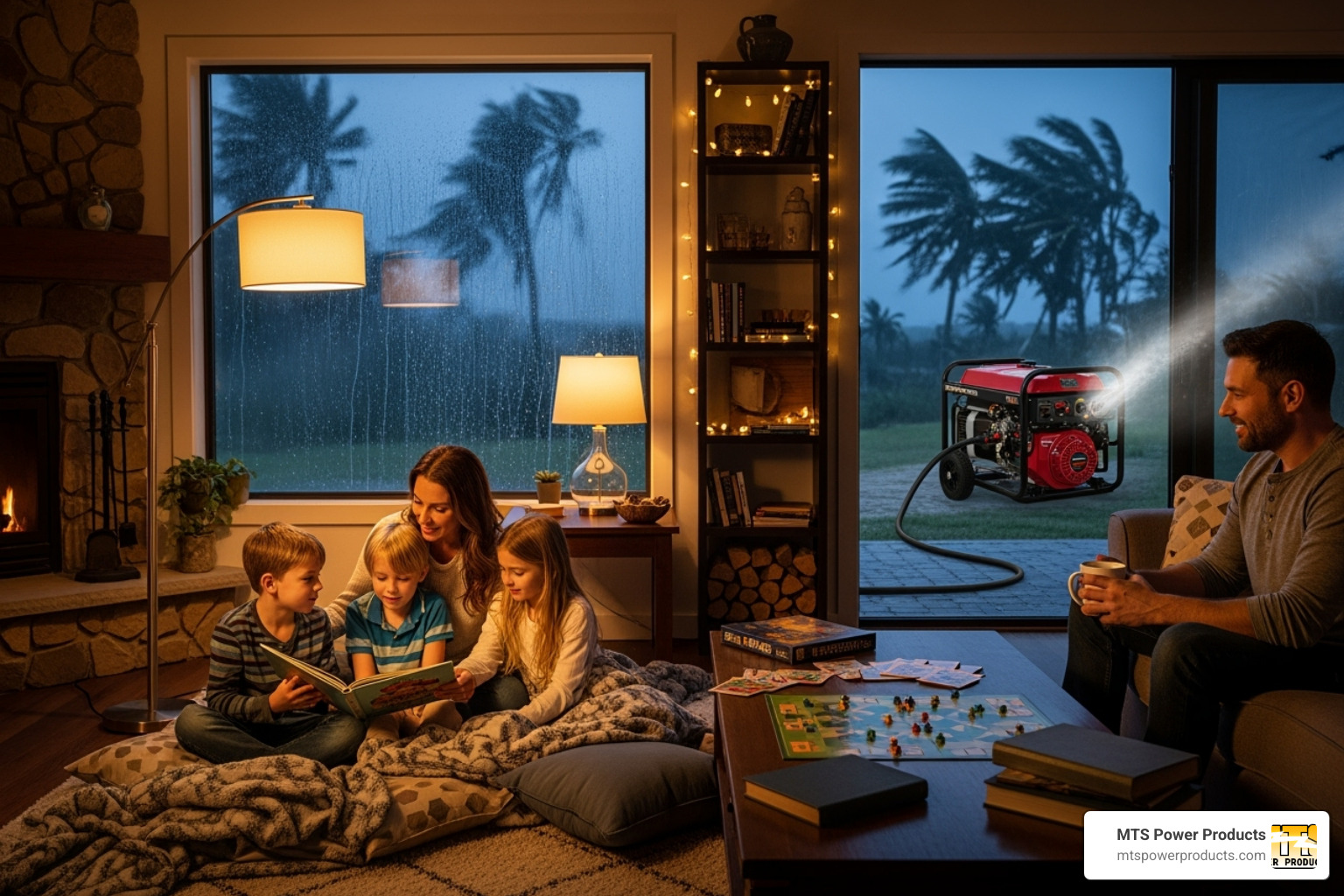
After exploring all the options, the choice really comes down to three key factors: your budget, how much convenience you want, and how often you’ll actually use your backup power system.
Interlock kits are the practical choice for homeowners who don’t mind a hands-on approach. They’re budget-friendly, reliable, and perfectly safe when installed correctly. If you’re comfortable flipping breakers and managing your power load manually, and you only face occasional outages, an interlock kit gets the job done without breaking the bank.
But here’s where things get exciting. For homeowners who want the ultimate in convenience and safety, an automatic interlock transfer switch transforms your entire backup power experience. Imagine never having to stumble outside in the dark during a storm, never worrying about whether you remembered the right sequence of switches, and never losing sleep over whether your elderly parents can safely operate their backup power system.
This is especially crucial for those of us here in South Florida, where hurricane season isn’t just a weather forecast – it’s a way of life. When you’re dealing with frequent power disruptions, the seamless operation of an automatic interlock transfer switch isn’t just convenient, it’s essential.
At MTS Power Products, we’ve seen how the right power solution can make all the difference. As a manufacturer and provider of generator sets, generator parts, and automatic transfer switches right here in Miami, we understand exactly what South Florida families and businesses need. We offer the distinct advantage of being a direct source for professional quality generators, control panels, voltage regulators, and so much more.
What really sets us apart is our customized line of McPherson Controls – professional quality commercial and residential power controls that go beyond basic functionality. These systems feature advanced remote monitoring capabilities and the highest safety standards, with programmable displays and sophisticated switch mechanisms that give you complete control and peace of mind.
Whether you’re looking for a straightforward, safe connection or a fully automated, state-of-the-art power management system, we have both the expertise and the products to match your exact needs. We’re centrally located within minutes of Miami International Airport and the Port of Miami, which means we can serve customers worldwide while maintaining that personal, local touch.
There really is no better company in South Florida to provide custom generators, transfer switches, and comprehensive power solutions. We’ve built our reputation on understanding that every home and business has unique power needs, and we’re here to help you find the perfect solution.
Ready to take the next step? Explore our complete range of Automatic Transfer Switches to find exactly what your home needs. Because when the next storm hits, you’ll want to be prepared for whatever comes your way.
